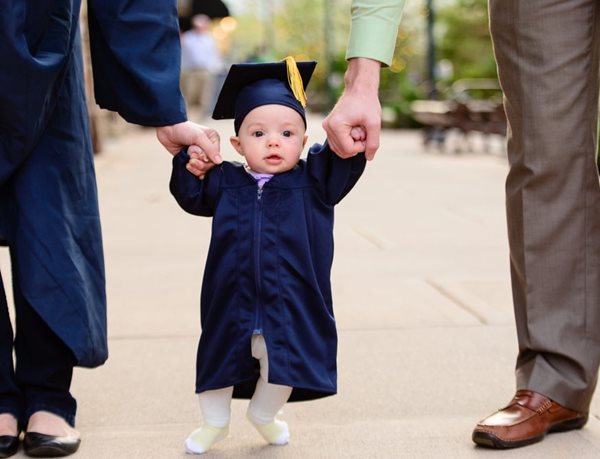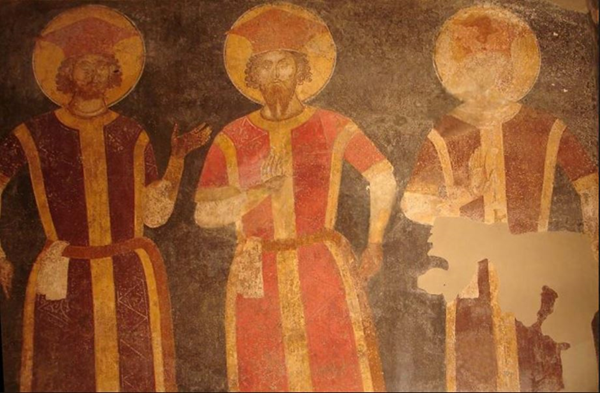‘Tis the season to graduate preschool, or move ‘up’ a room…
Danielle Bopping is one of Amplify’s original contributors and we’re always glad when she has time to put fingers to keyboard and share her thoughts. This is part one of a two-part reflection + advice article about the practice of early learning graduations.
Are they appropriate? Are they inclusive? Are they just for fun? Are they only there because ‘parents like it’? Do they disregard the work behind a ‘real’ graduation from school or university? Or are they a sincere means to recognise and support children’s growth and development from year to year?
In part one of this two-part series, Danielle sets the context for graduations through the ages and the dressing up – for adults and children – that accompany them. It’s an increasingly common practice, and increasingly commercialised, too. Most Australian graduation gown hire companies now have a ‘preschool/kindergarten’ category and we’ve heard of stretch limousines being hired in Sydney and Melbourne to take four and five year olds to their graduation parties.
Read on, and tell us what you think in the comments below.
Graduation
/ɡradʒʊˈeɪʃ(ə)n,ɡradjʊˈeɪʃ(ə)n/
noun
1. the receiving or conferring of an academic degree or diploma.
Transitions and rites of passage
The dictionary meaning of the word ‘graduation’ refers to the act of receiving a degree or diploma after engaging in a period of study.
Preschool children have absolutely been involved in a course of study. Theirs has involved studying the world around them through their work, otherwise known as play. During the year they have grown, not just physically, but in all areas of development and what they have learned in this time, about themselves, about others, about how things work, why things happen, how to solve problems and work together, and so much more is simply incredible.
We know it is vitally important that significant transitions are acknowledged and celebrated with our children. It is even more important that we are consulting with children to ensure we are doing this in a way that is meaningful for them.
Making it meaningful
We have seen a transformation in them and we are so proud of them. This absolutely deserves to be celebrated not just for them, but with them. This means in consultation and collaboration with them about how they would like to celebrate their achievements and to let them know, that as their educators, we valued so very much, the opportunity to share in the journey with them and their families.
A strong aspect of a child’s sense of identity is their ability to be able to engage in decision making about things that directly affect them. Their sense of pride in knowing that they contributed and scould actively exercise their sense of agency, ensure that they genuinely feel a part of the planning process and the outcome. It has far more meaning for children in this regard than just participating in something, which is supposed to be for them but about which all the decisions were made for them.

Time to rethink the cap and gown?
The history of wearing the cap and gown for graduation dates back centuries. In the 12th and 13th centuries, when universities first started to come into existence many of those who taught at the institutions were monks, priests or clerics.
The church was highly influential at the time and most students were studying to follow a similar path to their teacher or professor and so the long robes, or clerical attire became common place amongst teaching staff, professors and students. In those first ancient buildings and incarnations, of what we now refer to as university, it is thought that essentially long robes and hoods were also a necessity required by scholars to stay warm.
By 1321, clothing that was considered excessive was forbidden by Oxford and Cambridge universities for official graduation ceremonies and everyone was required to wear long robes to create unity. Note how different this is from the individuality and creativity which we strive so hard to ensure is nurtured in preschool!
The caps or mortar boardsare believed to have had their origins in the 15thcentury. They were fashioned after birettaswhich were hats worn by Catholic clerics, professors and scholars. The square shape of the modern-day mortar board might represent either the shape of a book, or the oldest quadrangle at Oxford university (Jesse Alexander, 2014).
� 
Robes for preschoolers in 2018
It is critically important that as educators we reflect on what significance this ancient adult tradition has for our children and whether it is appropriate to force this upon the children for whom we are advocates.
Why can’t children choose to wear and do something that is meaningful for them? Have the educators and adults consulted with the children about what they would like to wear? What is the motivation for dressing them up in the adult construct of the gown and mortar board?
Is it disrespectful and diminishing the achievement of those who have studied hard and long, often making incredible sacrifices to achieve the status of a degree or higher, by allowing children to be dressed in the same attire for finishing preschool?
What about the children who refuse to wear it because it is uncomfortable, unfamiliar or irritating to their skin? What about how their families will feel when it is their child that refuses to wear the cap or gown or spends the entire time struggling and fussing to keep it on. Has there been consultation with families?

Image Source: Discovery
But the children love it!
As for the argument the that children love dressing up, especially for a celebration, then why not let them choose their own special dress-up outfit? Something that they enjoy wearing, feel comfortable in, excited about and that has significance for them.
Of course there may be concerns about whether all families have or can afford to go and buy a dress up outfit, the Elsa dress, or latest version of Batman, so maybe children can wear their best clothes on the day and in the lead up they all make hats to wear, that demonstrate their creative, imaginative, design, problem solving and fine motor skills.
It’s time to think outside the box and move past the idea, “this is what we always do”, or “this is what the parents expect”.
What’s really special?
Surely it is not the gown and mortar board that makes the day special, for either the children or adults or that holds the key to creating the tear jerk moment adults?
Some of the children currently in my preschool room clearly remember the graduating class from last year, and when asked what they think they would like to wear this year the responses came, “a long black dress” and “a black hat”.
Arguably these ideas have come from the children, so providing the gown and hat for them to wear is justified. However, is it enough to just accept this response (because it fits with what parents and educators want) or should we challenge the children further to think about whether they really like it and why, and present them with alternatives and options?
Next week Danielle writes: what does a genuinely inclusive, child-focused graduation look like, and how can you have one?
Related articles
Meet the author

Danielle’s early childhood career began in 1997 when she completed an Advanced Diploma of Child Care Studies. Over the last 20 years, she has worked in a variety of early childhood settings, with children aged 0-12 years, in Australia, England, Ireland and Thailand. She recently completed a Bachelor of Education (0-5) years, the Adv. Dip of Community Sector Management and a Cert IV TAE. Currently she works part-time as a preschool teacher and teaches the Cert III and Diploma of Early Education and Care to foreign language students.